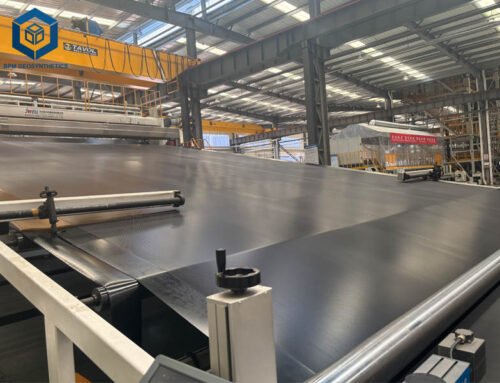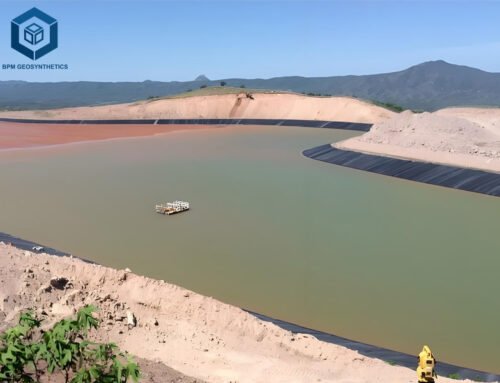Geosynthetic Clay Liner (GCL) is a composite geotechnical material that combines geosynthetic components with natural sodium bentonite clay. Its primary purpose is to serve as a barrier system in a variety of engineering applications, with notable use in landfill liners, containment ponds, and environmental remediation projects. GCLs consist of layers of geotextiles, either woven or non-woven, enclosing a core of bentonite clay. The geotextiles contribute to structural stability and reinforcement, while the bentonite clay swells when hydrated, creating a dense impermeable barrier that effectively prevents fluid migration. GCLs exhibit remarkable hydraulic performance, high shear strength, and reduced permeability, establishing them as a preferred choice for containment applications that demand efficient fluid containment and environmental protection.
BPM Geosynthetics manufactures and supplies high quality geosynthetic clay liners in bulk in custom sizes and properties at very competitive factory prices. We will discuss geosynthetic clay liner types, properties, applications and how to install them.
1. What Is Geosynthetic Clay Liner (GCL)?
The Geosynthetic Clay Liner (GCL) is an advanced reinforced composite material that offers superior performance and environmental sustainability. It is composed of two durable geotextile outer layers and a uniform core of natural sodium bentonite, forming a hydraulic barrier. The GCL combines these three primary components to deliver its functional properties.
The GCL incorporates a central layer of natural sodium bentonite clay, renowned for its remarkable water absorption and swelling characteristics. Upon hydration, the clay forms a highly impermeable barrier, effectively regulating fluid flow. This feature ensures the GCL’s ability to control and restrict the movement of fluids.
GCL incorporate geotextiles, which are commonly made from woven or non-woven synthetic fibers, as the protective layers surrounding the bentonite clay core. Geotextiles serve various essential roles within the GCL system. They offer reinforcement, separation, and filtration functions. These geotextiles distribute loads, preventing the mixing of clay with surrounding soils, while also controlling the migration of fine particles. Additionally, they allow water to permeate through the GCL, facilitating proper drainage.
GCL utilize bonding agents, such as powdered sodium bentonite or polymers, to enhance the interaction between the geotextiles and the bentonite clay. These bonding agents play a crucial role in establishing and maintaining the integrity of the GCL during installation and usage, thereby enhancing its overall effectiveness.


2.What Are the Features of Geosynthetic Clay Liner?
Geosynthetic Clay Liners (GCLs) possess several distinctive features that make them highly desirable for various engineering applications. Some of the key features of GCLs include:
2.1 Hydraulic Barrier Capability
GCLs exhibit a strong hydraulic barrier due to the low permeability of the bentonite clay core. This feature plays a crucial role in controlling the migration of fluids and effectively preventing any potential leakage.
2.2 Self-repairing Characteristics
GCLs possess self-healing properties, enabling them to autonomously seal minor punctures or damage. Upon hydration, the bentonite clay within the GCL swells, effectively closing any gaps or voids and ensuring the liner’s continuous performance.
2.3 Remarkable Swelling Ability
GCLs utilize sodium bentonite clay with exceptional water absorption and swelling characteristics. When hydrated, the clay undergoes significant expansion, resulting in the formation of a dense and impermeable barrier. This swelling capacity contributes to the GCL’s ability to effectively restrict the passage of water or fluids.
2.4 Environmental Friendliness
They are environmentally compatible solutions that do not contain any harmful chemicals or additives. They are non-toxic and exhibit compatibility with soil and groundwater systems. GCLs are designed to minimize any negative impact on the environment while providing effective containment and protection.
2.5 Robustness and Longevity
They are engineered to endure challenging environmental conditions and retain their functionality for an extended duration. They boast exceptional resistance to chemical degradation and physical stresses, ensuring their longevity and reliable performance over time. GCLs are built to withstand the rigors of their intended applications and maintain their effectiveness in demanding scenarios.
2.6 Convenient Installation
They are characterized by their lightweight and flexible nature, facilitating easy handling and installation. Their user-friendly design allows for swift deployment, resulting in reduced construction time and costs.
2.7 Adaptability
GCLs demonstrate remarkable versatility and can be employed across a diverse range of applications. They find utility in various sectors, including landfill liners, containment systems, mining operations, and environmental remediation projects. This adaptability highlights the broad functionality and wide-ranging benefits of GCLs.
3. What Is Best Geosynthetic Clay Liner Specifications?
| Properties | Unit | Test Method | Frequency | Value |
| Bentonite mass/g/m2 | g/m2 | ASTM D 5993 | 4000m2 | 3600g/m2 MARV |
| Tensile Strength | kN/m | ASTM D 6768 | 4000m2 | 6kN/m MARV |
| Peel Strength | N | ASTM D 4632 | 4000m2 | 65N MARV |
| Hydraulic conductivity | cm/s | ASTM D 5887 | periodically | 5×10–2cm/sec MARV |
| Shear Strength | kPa | ASTM D 6243 | periodically | 24 kPa Typical |
| Cap nonwoven geotextile | g/m2 | ASTM D 5261 | 20,000m2 | 200 g/m2 MARV |
| Swell index | Kg | ASTM D 5890 | 50,000Kg | 24ml/2g MARV |
| Moisture content | % | ASTM D 4643 | 50,000Kg | 12% max |
| Fluid loss | ml | ASTM D 5891 | 50,000Kg | 18ml max |
4. What Are Applications of Geosynthetic Clay Liners?
Geosynthetic Clay Liners (GCLs) find extensive applications in various engineering and environmental projects. Some common applications of GCLs include:
4.1 Landfill Liners and Caps
GCL is commonly used as part of landfill liner systems to contain and prevent the migration of leachate (liquid waste) into the surrounding soil and groundwater.
4.2 Containment Applications
GCL is employed in various containment applications, such as storage ponds, lagoons, and tanks. They provide an impermeable barrier that prevents the seepage of liquids and helps contain hazardous substances.
4.3 Mining Applications
GCL is used in mining operations for applications such as tailings dams, heap leach pads, and other containment structures.
4.4 Water and Wastewater Applications
Geosynthetic clay liner is used in the construction of reservoirs, ponds, canals, and other water containment structures.
4.5 Erosion Control
GCL is used in erosion control applications to stabilize slopes, embankments, and channels.
4.6 Road and Railway Construction
GCLs are utilized in road and railway construction projects as a part of the subgrade stabilization system to enhance soil strength, prevent water infiltration, and reduce erosion.
4.7 Remediation Projects
GCL is used in environmental remediation projects to contain and control the spread of contaminants.
4.8 Pond and Reservoir Liners
Geosynthetic clay liner is utilized for lining ponds, reservoirs, and other water containment structures.
5. What Kind Of Texture Conditions Use Geosynthetic Clay Liner?
Geosynthetic Clay Liners (GCLs) can be used in a wide range of texture conditions, including:
5.1 Areas with High Groundwater Levels
In areas with high groundwater levels, the ground is vulnerable to groundwater penetration and erosion. The use of geosynthetic clay liner can effectively prevent groundwater penetration and protect the stability of the ground.
5.2 Areas with Soft Soil
In areas with soft soil, the ground is easily affected by soil erosion and settlement. The use of geosynthetic clay liner can effectively prevent soil erosion and foundation settlement and protect the stability of the ground.
5.3 Areas with Large Slopes
In areas with large slopes, the ground is easily affected by water erosion, and the use of geosynthetic clay liner can effectively prevent water erosion and protect the stability of the ground.
5.4 Waterproof Treatment of Underground Buildings
In the waterproof treatment of underground buildings, the use of geosynthetic clay liner can effectively prevent groundwater penetration and leakage, and protect the structure and equipment of buildings.


6. How To Install Geosynthetic Clay Liner?
The installation of a Geosynthetic Clay Liner (GCL) typically involves the following steps:
6.1 Preparation Before Laying
Before laying the Geosynthetic Clay Liner, it is necessary to clean and treat the base layer to ensure that it is flat, clean, and free of loose substances and sharp objects. At the same time, it is also important to inspect the Geosynthetic Clay Liner to ensure that the quality and specifications of the material meet the construction requirements.
6.2 Laying of Geosynthetic Clay Liner
Lay the Geosynthetic Clay Liner on the base layer according to the design requirements, ensuring that it is flat, tight, and wrinkle-free. In the process of laying the Geosynthetic Clay Liner, the joints of the liner need to be welded or bonded to ensure the waterproof effect of the entire waterproof system.
6.3 Compaction and Coverage of Geosynthetic Clay Liner
Once the Geosynthetic Clay Liner (GCL) is positioned, compaction is performed to ensure a secure bond between the GCL and the underlying base layer. This compaction process tightly integrates the GCL with the base, enhancing its effectiveness as a waterproofing barrier. Subsequently, an overlay is applied to shield the GCL from potential harm and enhance the overall compression resistance of the waterproofing system.
6.4 Construction Quality Control
During the construction process of the Geosynthetic Clay Liner, it is essential to strictly control the construction quality to ensure the waterproofing effect and service life. This includes paying attention to the welding quality of the Geosynthetic Clay Liner, properly treating the seams, ensuring proper compaction, and maintaining the correct thickness and quality of the covering layer among other details.
7. Conclusion
Geosynthetic Clay Liners (GCLs) are versatile and highly efficient solutions for a wide range of geotechnical and environmental engineering projects. Their unique combination of hydraulic performance and mechanical robustness makes them an invaluable option for projects that require containment, erosion control, and environmental protection. GCLs provide a multifaceted and reliable approach to address the complex challenges faced in various engineering applications, ensuring optimal performance and long-term durability.
Any questions, please contact us.





